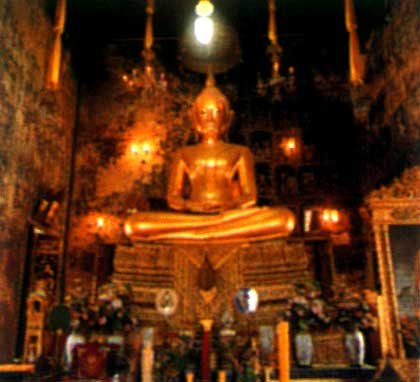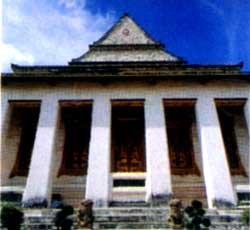Formerly named Wat Jomthong, this small but istorically important temple was built on the Wes in bank of Sanamchai Canal in the Ayutthaya period and later appointed as the Royal temple of King Rama III. The King favoured the Chinese style, and this distinguishes its buildings and interiors.
This is the first temple without such traditional decorations as chorfa, bairaka or hanghong. However, the Thai and Chinese styles harmonise well.
Ubosot: The main chapel has a Chinese-style roof, but Thai coloured tiles.
The tiles on the upper part ' of the pediment feature offerings; landscapes are on the lower part. Stuccochrysanthemum motifs surround the doors and windows. The principal Buddha image is one of the finest of its period. It is seated under the ninetierd parasol seen only in temples where the ashes of kings are laid to rest.
The Throne beneath the Pikul Tree: At the left han corner of the ubosot under an old pikul tree is the irge stone on which King Rama III as Crown Prir e was always seated when he came to visit the temple or to inspect the restoration work.
Wihan of the Reclining Buddha: The sermon hall :ontains a reclining Buddha image made of stucco. Descriptions of traditional medicine and massaige are inscribed on the outer wall along the verandah. The exterior door and window panels have  stucco reliefs of a Chinese guardian deity.
Wihan of the Standing Buddha: The prayer hall ontains a bronze standing Buddha image in
the  Forgiving posture, thought to have been cast in the   U- thong period.
John Crawford Britain's Ambassador to the Court of King Rama II once described this temple as  "the most beautifully built in Bangkok."
วันพฤหัสบดีที่ 19 กรกฎาคม พ.ศ. 2550
สมัครสมาชิก:
บทความ (Atom)

